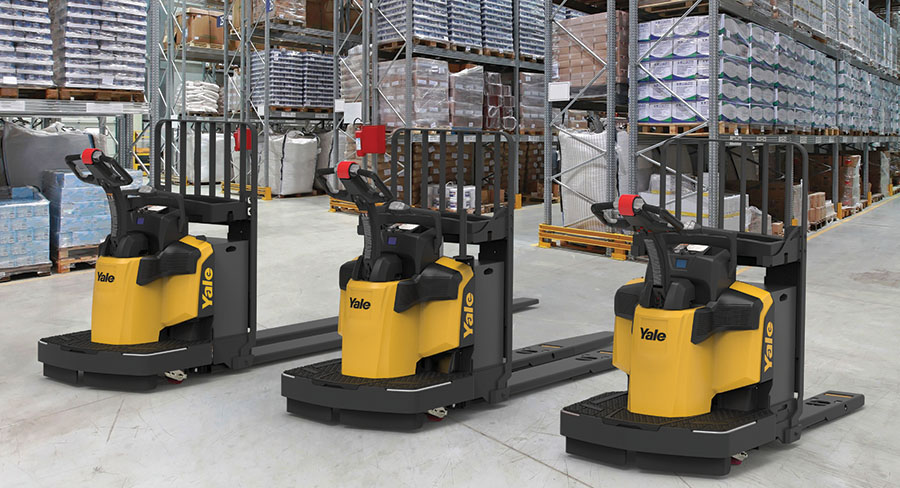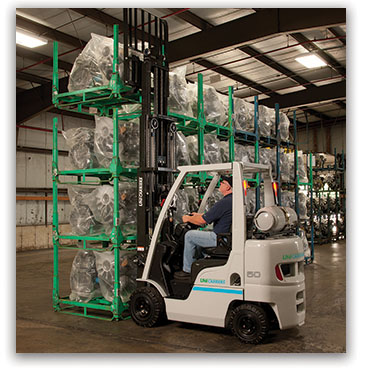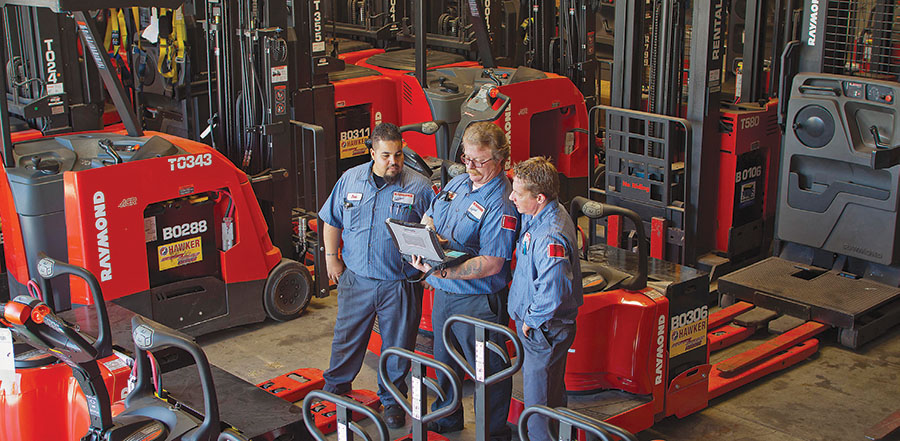How will your lift truck fleet navigate the next downturn?
The same forklift fleet management tools that cut their teeth guiding unprecedented industry growth could be tasked with curbing the same fleets.
The North American forklift market shattered sales records last year, while technology in and around lift trucks helped push fleets to new levels of productivity and efficiency. Whether or not you adopted telematics, data collection technologies helped fleet managers control costs as the economy grew and business boomed.
“We’ve talked about it for the past three years. The economy is on fire, things are growing, unemployment is down, but it can’t keep up at this rate,” says John Rosenberger, director of iWarehouse Gateway and global telematics for The Raymond Corp. “Nobody expects a cliff, but it is cooling down.”
According to Brian Markison, director of North American sales for UniCarriers Americas, the trend began toward the end of 2018. Although the record year finished with modest growth, the first half was up 14% and the second down 9%. Despite the deceleration heading into 2019, Markison says it’s a safe bet the coming year will still finish in the all-time top three.
“From a historical standpoint, it’s still looking like a reasonably solid year,” Markison says, “but I think everyone needs to have a cautious eye on a little bit of a cool down.”
Too many fleets, however, are not subject to the same sort of scrutiny applied to something like headcount. Companies accustomed to hiring temp workers in advance of peaks often keep the same equipment levels throughout the year. This is one of many reasons, according to Kevin Paramore, sales and marketing manager of motive power and telematics at Yale Materials Handling Corp., that the adoption of telematics is likely to continue its heavy growth.
“When times are good, costs aren’t as scrutinized as when things cool down,” says Paramore. “That’s when they start looking into detail to improve the model and cut costs. Telematics is independent of the economy. Without telematics, you’re operating with a blindfold, and you don’t have a leg to stand on to make knowledgeable decisions.”

Right-sizing a fleet can’t be done in a vacuum. Related tasks and processes must be considered when adding or removing equipment.
Don’t renege, renegotiate
Telematics have therefore become a requirement for many in the last three years. By the same token, any fleets that have not yet adopted them are unlikely to do so simply to manage a cooldown. UniCarriers’ Markison recognizes this hesitation among prospective clients, but emphasizes it takes time to get good trend data on cost.
“If you have a good 2019, it’s still a decent runway to get 12 to 24 months of data,” Markison says. “It’s still a good decision.”
Those who see a cool down coming and decide not to invest might be in for a shock. “Many of these fleet management products are services or operational expenses instead of capital spend,” Rosenberger says. “They are most needed when the bottom line is being hit. The times of being able to manage modern warehouses by roaming is gone.”
Looking around and proclaiming “the trucks look busy, so I’m good,” won’t cut it, Rosenberger adds. “Operations move too fast—products move too fast through them—for that to work.”
What does work is meeting things head-on. Contraction requires more efficiency, so it’s best to optimize the workforce you have to minimize the hit, Rosenberger says. Fleets with and without telematics will meet this with different strategies. Those with telematics and labor management have already recognized they can’t optimize what they’re not measuring, but even they might struggle to make some of the more drastic moves the data recommends.
“It sounds strange, but you have to believe in the data you have, even if there’s always a gray area at the bottom of the analytics,” Rosenberger says. “You see you have five more of this type of truck than you really need, but you only get rid of two until you get even more reassuring data. Think about what you’re going to do with the three.”
Can you renegotiate the lease? Buy it out? Or, maybe you reallocate those three trucks from a lease to a service, Rosenberger suggests, and get them back as needed through a dealer or third party. In any case, it’s possible to cautiously save money instead of cautiously spending it. Contract maintenance further protects against big blips like transmission failures, Rosenberger adds, which guarantees trucks will run and levels out expenses.
The service model fits so nicely into balance sheets that Rosenberger expects some will question ever returning to capital.
“It’s highly manageable from a finance point of view, even more so with contract maintenance,” he says. “Maybe I don’t have to invest in this equipment ever again, even as business heats back up.”
 Not too little, not too much
Not too little, not too much
Identifying a flex fleet is ideal, but at the very least it’s important to specify the outer parameters of the total fleet. Yale’s Paramore says telematics’ ability to inform equipment levels is critical in both a thriving and sluggish economy.
“Find the number that would be considered your floor in the worst case scenario and your ceiling when operations are wide open,” Paramore says. “Be honest. I walk into sites all the time where the No. 1 answer is ‘we need more trucks because we’re flat out all the time.’ These customers eventually realize there is a lot of opportunity when only a certain amount of those forklifts are in an accurate 2,000-hour lease.”
Among other things, telematics can expose concurrent use metrics. A fleet of 20, for example, might average 12 concurrent and reach a max of 15, but the data could show five were never used in May. Thankfully, trial and error is a perfectly acceptable way to approach matching lease terms with utilization. With good communication and commitments, lessor and lessee can find a way to make it work. Say you set up the schedule for 2,000 hours per year in a 20-truck facility. When only three of them hit 2,000 and the rest are at 500, it’s time to make a change.
“These scenarios happen all the time,” Paramore adds. “It’s not an extreme.”
Paramore says data can ensure that change is for the better. If you set all units back to 1,000-hour leases, some will pay an overage and plenty will still fall below, he says. You might manage utilization to be better spread across the fleet, or you can tailor the leases for three heavy-duty usage rates and the rest lower. Paramore says dealing with this proactively will always be better than paying overages.
When the bottom line is under a microscope, it’s nice to be able to directly tie expenses to productivity. Jim Gaskell, director of global technology and business development for Crown Equipment, says the forklift is an enabler for what moves through the warehouse.
“Most operations use a lot of technology to determine incoming and outgoing product,” Gaskell says, “but fleet management gives visibility into how the lift truck is being utilized to achieve that material flow.”

It takes time to collect trend data, which could help justify an investment in telematics in advance of an economic cool down.
On the enterprise scale, telematics can help curb a downturn’s impact on any one location by identifying the best ways to move under-used equipment from one facility to another. Leased or rented equipment can be returned, owners might park a few units, but Gaskell says fleet management is the best way to optimize those decisions.
Unsurprisingly, it’s unusual for those who have identified under-utilization to return leased equipment.
“Every company is trying to figure out how long the slump might last because they don’t want to be caught flat-footed if it picks back up,” Gaskell says.
The ebb and flow of business does not affect a fleet uniformly. Some units, for example those dedicated to “milk runs,” will be affected differently, and adjustments to one task can have knock-on effects on other forklift processes. Once again, Gaskell says, telematics provide essential insight into whether a specific model can be trimmed or if a decision will negatively affect operations.
In addition to isolating those units with the lowest run cost per hour, UniCarriers’ Markison encourages users to take advantage of lease terms. Paying attention to the number of hours run and gauging against output is easier with telematics, but Markison says anyone working with a lease can negotiate a cost-effective path through any change in utilization.
Maybe you take six months out and add it to the back end of the lease, Markison suggests, which would incur interest costs that are still much less than a lease payment—and end-of-lease options would remain in place.
Any changes to the fleet will affect its operators and the general workforce. If appropriate, have a plan to reassign operators to other tasks or departments. Fleet data will assist in identifying which operators are the most valuable.
“You want to keep those operators and make sure the cowboys are the first to go,” Markison says.

Article Topics
Warehouse News & Resources
The Ultimate WMS Checklist: Find the Perfect Fit 40th Annual Salary Survey: Salary and satisfaction up Data Capture: Bar coding’s new companions Salary Survey: Pay, satisfaction, youth on the rise Examining the impact of the Taiwan earthquake on global supply chain operations Reverse Logistics: Best Practices for Efficient Distribution Center Returns Exploring Customized Forklift Solutions More WarehouseLatest in Logistics
Baltimore suing ship that crashed into bridge, closing port, costing jobs Intermodal growth volume remains intact in March, reports IANA Descartes announces acquisition of Dublin, Ireland-based Aerospace Software Developments Amid ongoing unexpected events, supply chains continue to readjust and adapt Shipment and expenditure decreases trend down, notes Cass Freight Index March trucking tonnage trends down, reports ATA FTR Shippers Conditions Index enters negative territory More LogisticsAbout the Author
Subscribe to Logistics Management Magazine

Find out what the world's most innovative companies are doing to improve productivity in their plants and distribution centers.
Start your FREE subscription today.
April 2023 Logistics Management

Latest Resources
















